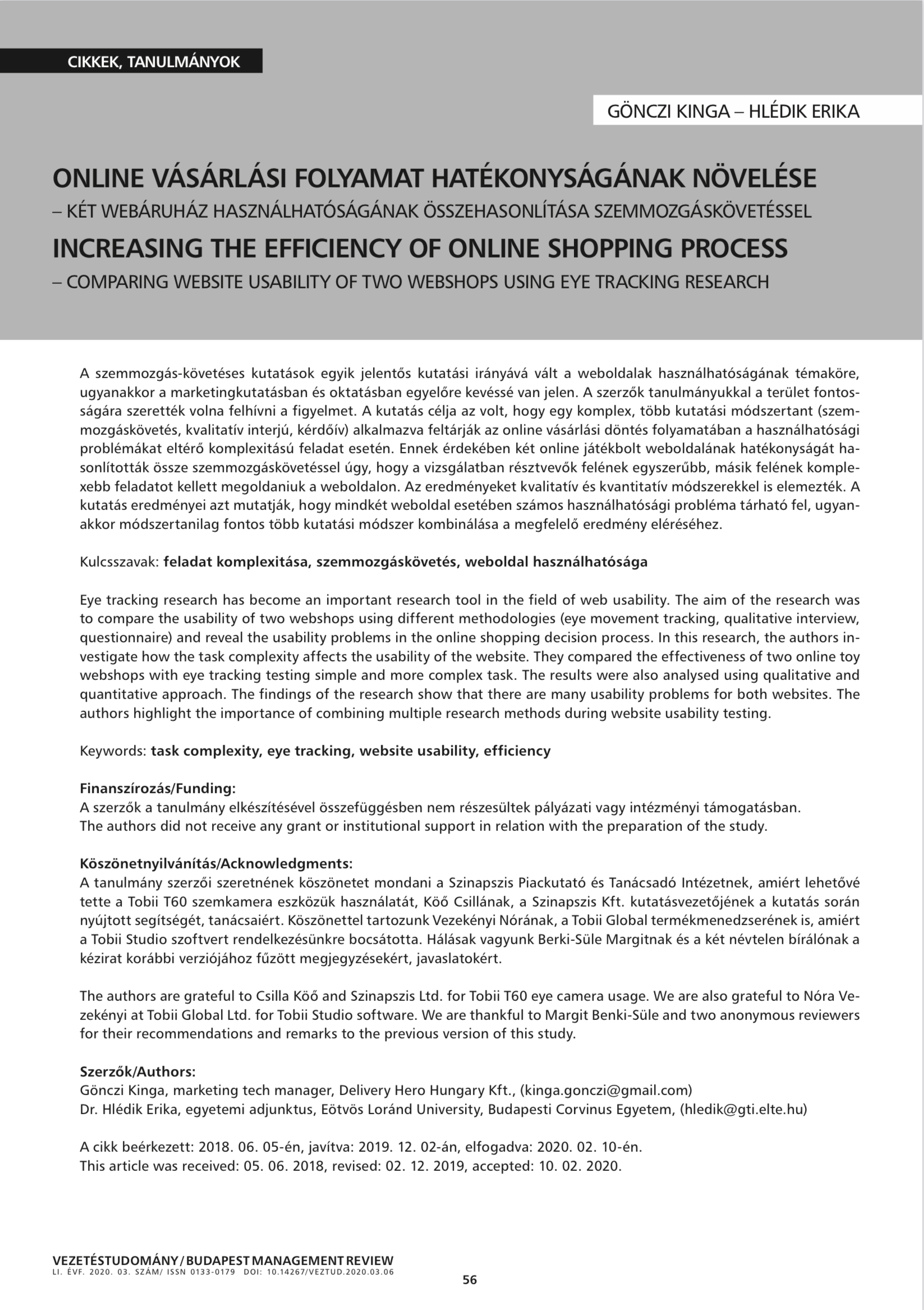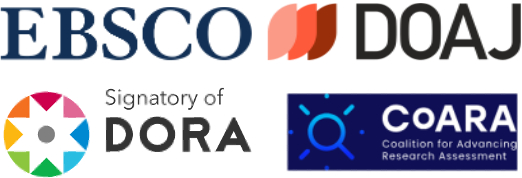Online vásárlási folyamat hatékonyságának növelése
Két webáruház használhatóságának összehasonlítása szemmozgáskövetéssel
DOI:
https://doi.org/10.14267/VEZTUD.2020.03.06Kulcsszavak:
feladat komplexitása, szemmozgáskövetés, weboldal használhatóságaAbsztrakt
A szemmozgás-követéses kutatások egyik jelentős kutatási irányává vált a weboldalak használhatóságának témaköre, ugyanakkor a marketingkutatásban és oktatásban egyelőre kevéssé van jelen. A szerzők tanulmányukkal a terület fontosságára szerették volna felhívni a figyelmet. A kutatás célja az volt, hogy egy komplex, több kutatási módszertant (szemmozgáskövetés, kvalitatív interjú, kérdőív) alkalmazva feltárják az online vásárlási döntés folyamatában a használhatósági problémákat eltérő komplexitású feladat esetén. Ennek érdekében két online játékbolt weboldalának hatékonyságát hasonlították össze szemmozgáskövetéssel úgy, hogy a vizsgálatban résztvevők felének egyszerűbb, másik felének komplexebb feladatot kellett megoldaniuk a weboldalon. Az eredményeket kvalitatív és kvantitatív módszerekkel is elemezték. A kutatás eredményei azt mutatják, hogy mindkét weboldal esetében számos használhatósági probléma tárható fel, ugyanakkor módszertanilag fontos több kutatási módszer kombinálása a megfelelő eredmény eléréséhez.
Letöltések
Hivatkozások
Bojko, A. (2005). Eye Tracking in User Experience Testing: How to Make the Most of It. In Proceedings of the UPA, Conference Research Gate (pp. 1-9). Montréal, Canada.
Bátor, A., Lógó, E., Pethő, B., Topa, Sz., & Veres, Z. (2015). Élelmiszeripari termékekre vonatkozó eladáshelyi kihelyezések hatékonyságának felmérésére alkalmas módszertan fejlesztése egy közepes méretű élelmiszerboltban. Az Egyesület Magyar Oktatásért és Kutatásért XXI. Országos Konferenciája, Budapest.
Cowen L., Ball L.J., & Delin J. (2002). An Eye Movement Analysis of Web Page Usability. In Faulkner X., Finlay J., & Détienne F. (Eds.), People and Computers XVI – Memorable Yet Invisible (pp. 317-335). London: Springer. https://doi.org/10.1007/978-1-4471-0105-5_19
Csépe, V., Győri, M., & Ragó, A. (2007). Általános pszichológia 1-3.-1. Észlelés és figyelem. Budapest: Osiris Kiadó.
Demeter, Gy., Pajkossy, P., Szőllősi, Á., Harsányi, A., Csigó, K., & Racsmány, M. (2015). Vizuális-téri emlékezeti funkciók vizsgálata kényszerbetegségben eye-tracker segítségével. In Magyar Pszichiátriai Társaság XIX. Vándorgyűlése, Január 28-31, Szeged.
Dickinger, A., & Stangl, B. (2013). Website performance and behavioral consequences: A formative measurement approach. Journal of Business Research, 66(6), 771-777. https://doi.org/10.1016/j.jbusres.2011.09.017
Duchowski, A. (2007). Eye Tracking Methodology, Theory and Practice. London: Springer. https://doi.org/10.1007/978-3-319-57883-5
Gere, A. (2015). Módszerfejlesztés a preferenciatérképezésben (PhD-dolgozat). Budapesti Corvinus Egyetem, Budapest.
Gere, A., Kókai, Z, & Sipos, L. (2017). Influence of mood on gazing behavior: Preliminary evidences from an eye-tracking study. Food Quality and Preference, 61, 1-5. https://doi.org/10.1016/j.foodqual.2017.05.004
Goldberg, J. H., Stimson, M. J., Lewenstein, M., Scott, N., & Wichansky, A. N. (2002). Eye tracking in web search tasks: design implications. In Proceedings of the 2002 symposium on Eye tracking research & applications (ETRA '02) (pp. 51-58). New York, NY: ACM. https://doi.org/10.1145/507072.507082
Graham, D. J., Orquin, J. L., & Visschers, V. H. M. (2012). Eye tracking and nutrition label use: A review of the literature and recommendations for label enhancement. Food Policy, 37(4), 378-382. https://doi.org/10.1016/j.foodpol.2012.03.004.
GKI Digital (2017). 1,2 milliárd euró felett a hazai online kiskereskedelem. Retrieved from: https://gkidigital.hu/2018/02/21/online-kiskereskedelem-2018/
Haak, van den M., De Jong, M., & Schellens, P. J. (2010). Retrospective vs. concurrent think-aloud protocols: Testing the usability of an online library catalogue. Behaviour & Information Technology, 22(5), 339-351. https://doi.org/10.1080/0044929031000
Hámornik, B. P., Hlédik, E., Józsa, E., & Lógó, E. (2013). Termékattribútumok vizuális keresése tejtermékek csomagolásán: az érdeklődési övezetek (AOI) kijelölésének két módszerének összehasonlítása. Marketing és Menedzsment, 47(3), 43–52.
Harridge-March, S. (2006). Can the building of trust overcome consumer perceived risk online? Marketing Intelligence & Planning, 24(7), 746-761. https://doi.org/10.1108/02634500610711897
Haubl, G., & Trifts, V. (2000). Consumer Decision Making in Online Shopping Environments: The Effects of Interactive Decision Aids. Marketing Science, 19(1), 4-21. https://doi.org/10.1287/mksc.19.1.4.15178
Hlédik E. (2015). Terméktulajdonságokkal kapcsolatos preferenciák stabilitásának vizsgálata a mobiltelefon példáján. Vezetéstudomány, 46(2), 25-34.
Hurley, R. A., Rice, J. C., Koefelda, J., Congdon, R., & Ouzts, A. (2017). The Role of Secondary Packaging on Brand Awareness: Analysis of 2 L Carbonated Soft Drinks in Reusable Shells Using Eye Tracking Technology: The Role of Secondary Packaging on Brand Awareness. Packaging Technology and Science. https://doi.org/10.1002/pts.2316
ISO 9241-11 (2018). Ergonomics of human-system interaction — Part 11: Usability: Definitions and concepts. Retrieved from: https://www.iso.org/obp/ui/#iso:std:iso:9241:-11:en
Joo, S., Lin, S., & Lu, K. (2011). A usability evaluation model for academic library websites: efficiency, effectiveness and learnability. Journal of Library and Information Studies, 9(2), 11-26. https://doi.org/10.1108/EL-04-2014-0067
Káldi, T., & Babarczy, A. (2018). Linguistic exhaustivity inference is context dependent: A visual-world eye-tracking study on Hungarian focus. Acta Linguistica Academica, 65(4), 547-595. https://doi.org/10.1556/2062.2018.65.4.2
Kohavi, R., & Thomke, S. (2017). The Surprising Power of Online Experiments: Getting the Most Out of A/B and Other Controlled Tests. Harvard Business Review, 95(5), 74–82.
Kovács, Á.M., Tauzin, T., Téglás, E., Gergely G., & Csibra, G. (2014). Pointing as epistemic request: 12-month-olds point to receive new information. INFANCY, 19(6), 543-557. https://doi.org/10.1111/infa.12060
Magyar Közlöny (2014). A Kormány 45/2014. (II.26) Korm. rendelete a fogyasztó és a vállalkozás közötti szerződések részletes szabályairól. Magyar Közlöny, 30. Retrieved from http://www.kozlonyok.hu/nkonline/mkpdf/hiteles/mk14030.pdf
Malhotra, N. & Simon, J. (2009). Marketingkutatás. Budapest: Akadémiai Kiadó.
Pavlou, P. A., & Fygenson, M. (2006). Understanding and predicting electronic commerce adoption: An extension of the Theory of Planned Behavior. MIS Quaterly, 30(1), 115-143. https://doi.org/10.2307/25148720
Pfeiffer, J., Meißner, M., Prosiegel, J., & Pfeiffer, T. (2014). Classification of Goal-Directed Search and Exploratory Search Using Mobile Eye-Tracking. Proceedings of the International Conference on Information Systems, (ICIS 2014).
Punj, G. (2012). Consumer Decision Making on the Web. A Theoretical Analysis and Research Guidelines. Psychology and Marketing, 29(10), 791–803. https://doi.org/10.1002/mar.20564
Schenkman, B.N., & Jönsson, F.U. (2000). Aesthetics and preferences of web pages. Behavior and Information Technology, 19(5), 367-377. https://doi.org/10.1080/014492900750000063
Schroeder, S., Hyönä, J., & Liversedge, S. (2015). Developmental eye-tracking research in reading: Introduction to the special issue. Journal of Cognitive Psychology, 27, 500-510. https://doi.org/10.1080/20445911.2015.1046877
Senju, A., & Csibra, G. (2008). Gaze following in human infants depends on communicative signals. Current Biology, 18, 668–671. https://doi.org/10.1016/j.cub.2008.03.059
Szabó, B. (2015). Rivalizáló reklámok hatásainak szemmozgáskövetéses pilot vizsgálata dinamikus AOI funkció segítségével. In Budapesti Műszaki és Gazdaságtudományi Egyetem Menedzsment és Vállalatgazdaságtan Tanszék (szerk.), Az Egyesület a Marketing Oktatásért és Kutatásért XXI. országos konferenciájának tanulmánykötete (pp. 356-364). Budapest: Magyarország: BME.
Varga, Á. (2018). Fogyasztói neurotudomány, neuromarketing és egyéb boszorkányságok. In Csordás, Tamás & Varga, Ákos (szerk.), MMDC terelő: Tanulmányok a marketing-, média- és designkommunikáció területéről (pp. 75-82). Budapest: Budapesti Corvinus Egyetem. Retrieved from: http://unipub.lib.uni-corvinus.hu/3916/
Varga, Á. (2016). Neuromarketing, a marketingkutatás új iránya. Vezetéstudomány, 47(9), 55-63.
Varga, Á., & Kemény, I. (2016). Examining Young People's Attitude toward Special Domestic Items in Hungary. European Journal of Business Science and Technology, 2(2), 140-150. https://doi.org/10.11118/ejobsat.v2i2.40
Varga, Á., Simon, J., Horváth, D., & Pintér, A. (2014). Az érzelmek és az agy, fókuszban a neuromarketing kutatás. In Hetesi, E. & Révész, B. (szerk.), „Marketing megújulás”: Marketing Oktatók Klubja 20. Konferenciája (pp. 425-431). Szeged, Magyarország: SZTE GTK.
Vos, A, Marinagi, C., Trivellas, P., Eberhagen, N., Skourlas, Ch., & Giannakopoulos, G. (2014). Risk Reduction Strategies in Online Shopping: E-trust Perspective, Procedia. Social and Behavioral Sciences, 1 47, 4 18 – 4 23. h ttps://doi.org/10.1016/j.sbspro.2014.07.122
Wade, N. J. (2010). Pioneers of eye movement research. I-Perception, 1(2), 33–68. https://doi.org/10.1068/i0389
Wang. Q., Yang. S., Liu. M., Cao Z., & Ma. Q. (2014). An eye-tracking study of website complexity from cognitive load perspective. Decision Support Systems, 62, 1-10. https://doi.org/10.1016/j.dss.2014.02.007

Downloads
Megjelent
Hogyan kell idézni
Folyóirat szám
Rovat
License
Authors assign copyright to Vezetéstudomány / Budapest Management Review. Authors are responsible for permission to reproduce copyright material from other sources.

